#Amin Jafari
Text
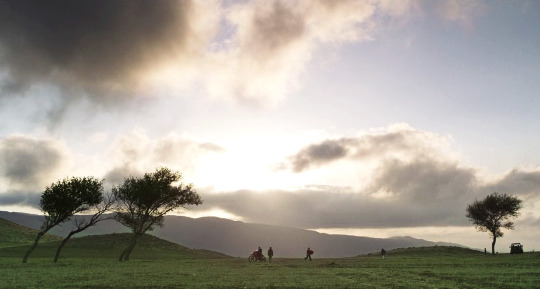
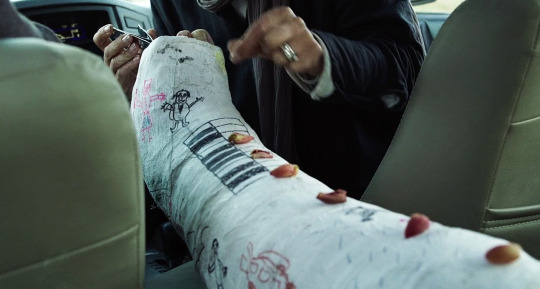
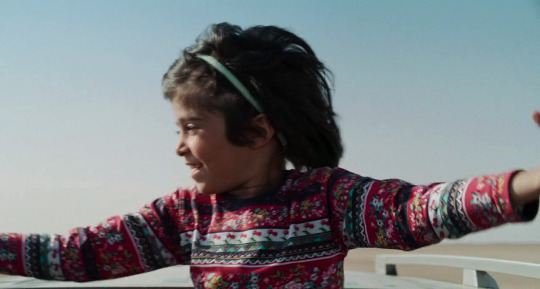



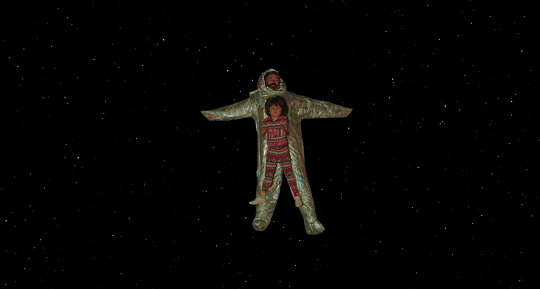
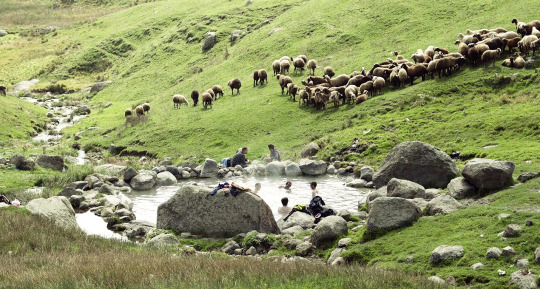
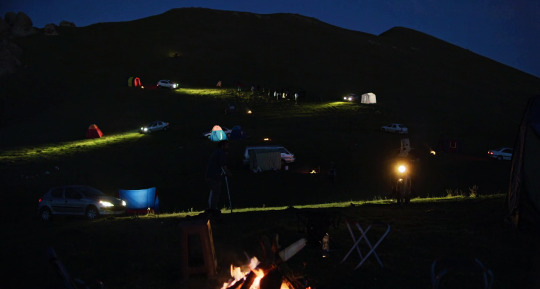

Hit the Road (2021)
Directed by Panah Panahi
Cinematography by Amin Jafari
16 notes
·
View notes
Photo
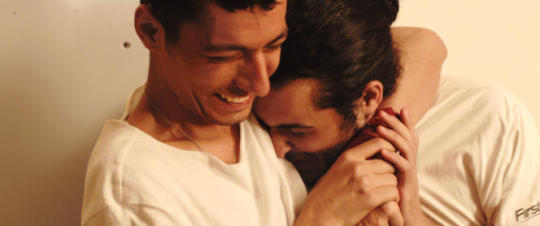
A Tale of Shemroon (Chevalier noir), Emad Aleebrahim-Dehkordi (2022)
#Emad Aleebrahim Dehkordi#Iman Sayad Borhani#Payar Allahyari#Behzad Dorani#Masoumeh Beigi#Paul Ilia Aleebrahim Dehkordi#Aisan Ghanbari#Amirreza Ranjbaran#Sam Daneshvar#Amin Jafari#Félix Rehm#2022
0 notes
Photo
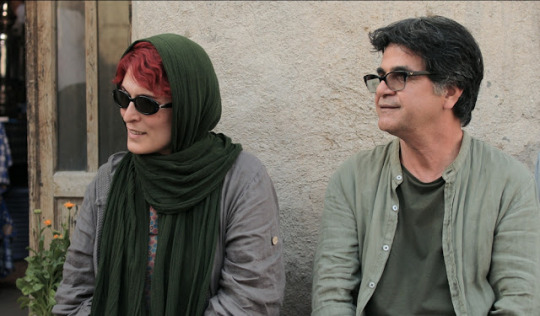
Behnaz Jafari and Jafar Panahi in 3 Faces (Jafar Panahi, 2018)
Cast: Behnaz Jafari, Jafar Panahi, Marziyeh Rezaei, Maedeh Erteghaei, Narges Delaram. Screenplay: Jafar Panahi, Nader Saeivar. Cinematography: Amin Jafari. Production design: Leila Naghdi Pari. Film editing: Mastaneh Mohajer, Panah Panahi.
It's probable that, because of my superficial acquaintance with Iranian film, I kept comparing Jafar Panahi's 3 Faces to films by Abbas Kiarostami. Like Kiarostami's And Life Goes On (1992), it concerns a journey from Tehran into the remote villages of the country, and like that film and his Through the Olive Trees (1994), it ends with a virtually wordless scene shot from a long distance. But from what I know from reading about Panahi and his work, this may be more hommage than mimicry: Panahi, who is forbidden from making films in Iran and nevertheless has made four since he was imprisoned and sanctioned, is keen to make statements about life and art in his country, and allusions to its most celebrated director are certainly in order. 3 Faces follows the actress Behnaz Jafari and Panahi, playing themselves, as they journey into northwestern Iran to try to find Marziyeh, a young woman who wants to attend the conservatory in Tehran and become an actress. In a desperate attempt to elicit their help, Marziyeh has made a video on her phone in which she appears to commit suicide. She sent the video to Jafari, who is so shocked by it that she drops out of the film she's making and enlists Panahi in trying to track down the young woman. What follows has been called a "road movie," in which actress and director drive an SUV along dirt roads deep into the hills to find out if Marziyeh really committed suicide or if she faked it to get attention. The bulk of the film is made up of some oddball encounters along the way and a struggle with the villagers who detest Marziyeh for her nonconformity, as well as with the woman's family, which is at odds over her ambitions. Marziyeh turns up alive, having taken shelter with Shahrzad, a former actress whose career ended with the Iranian revolution, and who lives a hermit-like life in this remote village, regarded with suspicion by the locals. "Shahrzad" is one of several spellings of "Scheherazade," the legendary storyteller of the One Thousand and One Nights. We never see the film's Shahrzad, but she's central to the film's themes; for one thing, the name means "world-freer." The family member most opposed to Marziyeh's pursuit of a career is her brother, who is so angry about his sister's flouting of tradition that he has to be restrained and shut in his room when Jafari and Panahi arrive at the family home. At the end, when Marziyeh's father is asked for permission to let her go to Tehran with the actress and the director, we see Panahi waiting outside -- Jafari has told him that it's best to let the women handle it -- as the furious brother emerges. The men keep their distance; Panahi gets out of the car and looks through a wire fence as we see the brother pick up a stone; then we hear the sound of a car alarm. The film cuts to an interior of the SUV as it drives along the familiar winding road, heading back to Tehran. There's a large cracked spot on the windshield. The beautiful understatement of scenes like this only heightens our sense of the injustice done by politics to art.
3 notes
·
View notes
Text
3 Faces (Se rokh)
Today's review on MyOldAddiction.com, 3 Faces by #JafarPanahi, "endlessly watchable thanks to the filmmaker's special talent for creating situations that feel like they just naturally unfold"
JAFAR PANAHI
Bil’s rating (out of 5): BBBB.
Iran, 2018. Jafar Panahi Film Productions, Kino Lorber. Screenplay by Jafar Panahi, Nader Saeivar Cinematography by Amin Jafari. Produced by Jafar Panahi. Production Design by Leila Naghdi Pari. Costume Design by Leila Naghdi Pari. Film Editing by Mastaneh Mohajer, Panah Panahi. Cannes Film Festival 2018. Toronto International Film…
View On WordPress
#Amin Jafari#Behnaz Jafari#Cannes 2018#Iran#Jafar Panahi#Jafar Panahi Film Productions#Kino Lorber#Leila Naghdi Pari#Maedeh Erteghaei#Marziyeh Rezaei#Mastaneh Mohajer#Nader Saeivar#Narges Delaram#Panah Panahi#TIFF 2018
0 notes
Link
Amin Jafari Sojahrood says he felt at home right away in Canada after arriving from Iran to study biomedical physics.
He has since achieved many educational accolades, including winning a prestigious Vanier scholarship. Ivy League schools and high-profile institutions across the world have been trying to recruit him for years. But he loves Canada and wants to build a life here.
That’s why he says it has been heartbreaking to have found himself in limbo awaiting approval for permanent residency. He’s been waiting over a year for his application to be processed with no end in sight.
And it’s all because he is from Iran.
Continue Reading.
38 notes
·
View notes
Text
During the world cup many Iranians watched the matches in cafés, restaurants, shops or public screenings. After each match people flooded the streets to celebrate and show their support for the team; Iran achieved their best performance at a world cup. They finished third in their group with four points and overall in 18th place out of 32 squads.*
Iranian fans in Isfahan celebrating the performance of their team after the group stage. Photo credit: Mohammad Reza Jafari, Young Journalists Club.
Iranian fans in Tehran celebrating the performance of their team after the group stage. Photo credit: IRNA.
Iranian fans in Tehran celebrating the performance of their team after the group stage. Photo credit: IRNA.
Iranian fans watching the match in Tehran. Photo credit: Reza Zangeneh, ISNA.
Iranian fans watching the match. Photo credit: Arya Jafari, ISNA.
Iranian fans watching the match in a café in Tehran. Photo credit: Hamid Amlashi, ISNA.
Iranian fans watching the match in a restaurant, Tehran. Photo credit: Rouhollah Vahdati, ISNA.
Iranian fans before the match on their way to Azadi Stadium, Tehran. Photo credit: Amir Kholousi, ISNA.
Iranian fans watching the match in Azadi Stadium, Tehran. Photo credit: Amir Kholousi, ISNA.
Iranian fans watching the match in Azadi Stadium, Tehran. Photo credit: Amir Kholousi, ISNA.
Iranian fans watching the match in Azadi Stadium, Tehran. Photo credit: Amir Kholousi, ISNA.
Iranian fans watching the match in Charsou Cineplex, Tehran. Photo credit: Hemmat Khahi, ISNA.
Iranian fans watching the match in Charsou Cineplex, Tehran. Photo credit: Mehran Riazi, ISNA.
Iranian girl wearing a Real Madrid jersey in Charsou Cineplex, Tehran. Photo credit: Mehran Riazi, ISNA.
Iranian fans watching the match in Kish Island, Hormozgan. Photo credit: Ayoub Ghareri, Young Journalists Club.
Iranian fans watching the match in Tehran. Photo credit: Reza Zangeneh, ISNA.
Iranian fans watching the match in Azadi Stadium, Tehran. Photo credit: Mohammad Mohsenifar, MEHR News Agency.
Iranian fans watching the match in Hamedan. Photo credit: Mohammad Amin Najafi, Young Journalists Club.
Iranian fan during half time in Azadi Stadium, Tehran. Photo credit: IRNA.
Iranian fans after the match at Azadi Stadium, Tehran. Photo credit: Mohammad Mohsenifar, MEHR News Agency
Iranian fans after the match at Azadi Stadium, Tehran. Photo credit: IRNA.
Iranian fans watching the match in Charsou Cineplex, Tehran. Photo credit: Hemmat Khahi, ISNA.
Iranian fans watching the match in Hamedan. Photo credit: Mohammad Amin Najafi, Young Journalists Club.
Iranian fans celebrating the victory of their team at Tajrish Square in Tehran. Photo credit: Atiyeh Niknam, Tehran Picture Agency.
Iranian fans celebrating the victory of their team at Tajrish Square in Tehran. Photo credit: Atiyeh Niknam, Tehran Picture Agency.
Iranian fans celebrating the victory of their team in Mashhad, Razavi Khorasan. Photo credit: Ahmad Hasani, Young Journalists Club.
Iranian fan celebrating the victory of her team in Rasht, Gilan. Photo credit: IRNA.
Iranian fans celebrating the victory of their team in Tehran. Photo credit: Behnam Tofighi, MEHR News Agency.
Iranian fans celebrating the victory of their team in Tehran. Photo credit: Shayan Mehrabi, Tehran Picture Agency.
Iranian fans celebrating the victory of their team in Tehran. Photo credit: Behnam Tofighi, MEHR News Agency.
Iranian fans celebrating the victory of their team in Tehran. Photo credit: Shayan Mehrabi, Tehran Picture Agency.
Iranian fans celebrating the victory of their team in Tehran. Photo credit: Behnam Tofighi, MEHR News Agency.
Iranian kids celebrating the victory of their team in Tehran. Photo credit: Majid Asgaripour, MEHR News Agency.
Iranian fans celebrating the victory of their team in Tehran. Photo credit: Majid Asgaripour, MEHR News Agency.
Iranian fans celebrating the victory of their team in Tehran. Photo credit: Majid Asgaripour, MEHR News Agency.
Iranian fans celebrating the victory of their team in Tehran. Photo credit: Abdolvahed Mirzazadeh, ISNA.
Iranian fans celebrating the victory of their team in Tehran. Photo credit: BORNA.
Iranian fans celebrating the victory of their team in Tehran. Photo credit: Hemmat Khahi, ISNA.
Iranian fans celebrating the victory of their team in Tehran. Photo credit: Rouhollah Vahdati, ISNA.
Iranian fans watching the match in Abbasabad, Hamedan. Photo credit: Behzad Alipour, FARS News Agency.
Iranian fans watching the match in Charsou Cineplex, Tehran. Photo credit: Alireza Farahani, Young Journalists Club.
Iranian fans watching the match in Ekbatan, Tehran. Photo credit: Majid Asgaripour, MEHR News Agency.
Iranian fans watching the game in Rasht, Gilan. Photo credit: Mohammad Moheimany, MEHR News Agency.
Iranian president Hassan Rouhani watching the match. Photo credit: IRNA.
Iranian fans waiting for the match to start in Charsou Cineplex, Tehran. Photo credit: Nasim Aghaei, Young Journalists Club.
Iranian fans watching the match in a restaurant in Tehran. Photo credit: Hemmat Khahi, ISNA.
Iranian fans watching the match in Charsou Cineplex, Tehran. Photo credit: Mehran Riazi, ISNA.
Iranian fans watching the match in Charsou Cineplex, Tehran. Photo credit: Nasim Aghaei, Young Journalists Club.
Iranian fans watching the match in Tehran. Photo credit: Ali Taghavi, ISNA.
Iranian fans watching the match in Tehran. Photo credit: Ali Taghavi, ISNA.
Iranian fans watching the match in Tehran. Photo credit: Ali Taghavi, ISNA.
Iranian girl celebrating the victory of her team in Hamedan. Photo credit: Mohammad Amin Najafi, Young Journalists Club.
Iranian girl celebrating the victory of her team in Tehran. Photo credit: Alireza Farahani, Young Journalists Club.
An own goal by Aziz Bouhaddouz (90+5′) allowed Iran to win their first match 1:0 against Morocco. Spain won the second match 1:0 (Diego Costa 54′) but the Europeans struggled to create chances against a very disciplined Iran that defended brilliantly, showed plenty of tactical cohesion and looked dangerous going forward. Saeid Ezatolahi had a goal disallowed for offside.
The third match against Portugal ended in a draw 1:1 (Quaresma 45′; penalty Karim Ansarifard 90+3′). Morteza Pouraliganji rose up to the challenge and kept Cristiano Ronaldo in check. In the second half, Ali Beiranvand managed to save Ronaldo’s penalty kick. Seconds before the final whistle, Iran went all out for the winner and a desperate Saman Ghoddos effort was deflected onto the path of Mehdi Taremi who found himself one-on-one with Portuguese goalkeeper Rui Patricio. Taremi hit the wrong side of the netting, consigning his side to finishing third in their group. Iran needed all three points to advance to the knock-out stage.
In The Guardian, Paul Doyle rated Ali Beiravand’s overall performance with an 8 and chose the Iranian goalkeeper in his best eleven of the group stage.
*Note: In 1978, Iran finished in 14th place out of 16 participants on their first World Cup appearance.
Sources: Borna News Agency, Fars News Agency (FNA) 1, FNA 2, IRNA 1, IRNA 2, IRNA 3, IRNA 4, IRNA 5, IRNA 6, IRNA 7, ISNA 1, ISNA 2, ISNA 3, ISNA 4, ISNA 5, ISNA 6, Mehr News Agency (MNA) 1, MNA 2, MNA 3, MNA 4, MNA 5, MNA 6, MNA 7, MNA 8, MNA 9, Tasnim News Agency (TNA) 1, TNA 2, Tehran Picture Agency (TPA) 1, TPA 2, TPA 3, Young Journalists Club (YJC) 1, YJC 2, YJC 3, YJC 4, YJC 5, YJC 6, YJC 7, AFC, The Guardian (TG) 1, TG 2, Wikipedia 1, Wikipedia 2, Wikipedia 3
Photo gallery: Fans in Iran @2018 FIFA World Cup During the world cup many Iranians watched the matches in cafés, restaurants, shops or public screenings. After each match people flooded the streets to celebrate and show their support for the team; Iran achieved their best performance at a world cup.
4 notes
·
View notes
Text
Tiny bubbles making large impact on medical ultrasound imaging
Tiny bubbles making large impact on medical ultrasound imaging
New research demonstrates ability to manipulate nanobubble size, acoustic resonance and, ultimately, ultrasound effectiveness
Credit: Amin Jafari Sojahrood and Al C. de Leon
If you were given “ultrasound” in a word association game, “sound wave” might easily come to mind. But in recent years, a new term has surfaced: bubbles. Those ephemeral, globular shapes are proving useful in improving…

View On WordPress
0 notes
Photo

[TASK 048: IRAN]
Shout out to anon for inspiring this task! There’s a masterlist below compiled of over 140+ Iranian faceclaims categorised by gender with their occupation and ethnicity denoted if there was a reliable source. If you want want an extra challenge use random.org to pick a random number! Of course everything listed below are just suggestions and you can pick whichever character or whichever project you desire.
Any questions can be sent here and all tutorials have been linked below the cut for ease of access! REMEMBER to tag your resources with #TASKSWEEKLY and we will reblog them onto the main! This task can be tagged with whatever you want but if you want us to see it please be sure that our tag is the first five tags!
THE TASK - scroll down for FC’s!
STEP 1: Decide on a FC you wish to create resources for! You can always do more than one but who are you starting with? There are links to masterlists you can use in order to find them and if you want help, just send us a message and we can pick one for you at random!
STEP 2: Pick what you want to create! You can obviously do more than one thing, but what do you want to start off with? Screencaps, RP icons, GIF packs, masterlists, PNG’s, fancasts, alternative FC’s - LITERALLY anything you desire!
STEP 3: Look back on tasks that we have created previously for tutorials on the thing you are creating unless you have whatever it is you are doing mastered - then of course feel free to just get on and do it. :)
STEP 4: Upload and tag with #TASKSWEEKLY! If you didn’t use your own screencaps/images make sure to credit where you got them from as we will not reblog packs which do not credit caps or original gifs from the original maker.
THINGS YOU CAN MAKE FOR THIS TASK - examples are linked!
Stumped for ideas? Maybe make a masterlist or graphic of your favourite Indonesian faceclaims. A masterlist of names. Plot ideas or screencaps from a music video preformed by a Indonesian artist. Masterlist of quotes and lyrics that can be used for starters, thread titles or tags. Guides on Indonesian culture and customs.
Screencaps
RP icons [of all sizes]
Gif Pack [maybe gif icons if you wish]
PNG packs
Manips
Dash Icons
Character Aesthetics
PSD’s
XCF’s
Graphic Templates - can be chara header, promo, border or background PSD’s!
FC Masterlists - underused, with resources, without resources!
FC Help - could be related, family templates, alternatives.
Written Guides.
and whatever else you can think of / make!
MASTERLIST!
Note: If you’re using this masterlist for casting purposes please do further research before casting any of the following because some pages only listed their nationalities!
Thank you to @warflowered for some of these suggestions!
Ladies:
Soraya Ghasemi (77) Iranian - actress.
Pouri Banayi (76) Iranian - actress.
Maryam Amir Jalali (69) Iranian - actress and singer.
Susan Taslimi (67) Iranian - actress, film director, theatre director, and screenwriter.
Googoosh (66) Iranian singer and actress of Iranian Azerbaijani origin.
Shohreh Aghdashloo (65) Iranian - actress.
Golab Adineh (63) Iranian - actress.
Gohar Kheirandish (62) Iranian - actress.
Afsar Asadi (59) Iranian - actress and make-up artist.
Azita Hajia (59) Iranian - actress.
Leila Forouhar (59) Iranian - pop singer and actress.
Bita Farrahi (59) Iranian - actress.
Roya Teymourian (58) Iranian - actress.
Akram Mohammadi (58) Iranian - actress.
Zohreh Mojabi (57) Iranian - actress and playwright.
Afsaneh Bayegan (56) Iranian - actress and beauty pageant titleholder.
Fatemeh Motamed-Arya (55) Iranian - actress.
Katayoun Riahi (55) Iranian - actress.
Roya Nonahali (54) Iranian - actress.
Fatemeh Goudarzi (53) Iranian - actress.
Yasmin Le Bon (52) Iranian / English - model.
Laya Zanganeh (51) Iranian - actress.
Mandana Jones (50) Iranian / Welsh - actress.
Shiva Rose (48) Iranian / Irish, Ashkenazi Jewish, Welsh - actress, activist, and blogger.
Ateneh Faghih Nasiri (48) Iranian - actress.
Pantea Bahram (47) Iranian - actress.
Parastoo Golestani (46) Iranian - actress.
Mahtab Keramati (46) Iranian - actress.
Atoosa Rubenstein (45) Iranian - magazine editor.
Niki Karimi (45) Iranian - actress, director, and screenwriter.
Ladan Mostofi (44) Iranian - actress.
Leila Hatami (44) Iranian - actress and director.
Falamak Joneidi (44) Iranian - actress.
Leyli Rashidi (44) Iranian - actress.
Hedieh Tehrani (44) Iranian - actress.
Shaghayegh Farahani (44) Iranian - actress.
Vishka Asayesh (44) Iranian - actress, set designer and art director.
Anahita Hemmati (43) Iranian - actress.
Sahar Zakaria (43) Iranian - actress.
Merila Zarei (43) Iranian - actress.
Behnoosh Bakhtiari (42) Iranian - actress.
Behnaz Jafari (42) Iranian - actress.
Maya Sansa (41) Iranian / Italian - actress.
Mitra Hajjar (40) Iranian - actress.
Saba Kamali (40) Iranian - actress.
Zuleikha Robinson (39) Indian, English, possibly Iranian and Scottish - actress and singer.
Elham Hamidi (39) Iranian - actress.
Mahnaz Afshar (39) Iranian - actress.
Shabnam Gholikhani (39) Iranian - actress and director.
Hadis Fooladvand (39) Iranian - actress.
Ana Nemati (39) Iranian - actress and model.
Anahita Nemati (39) Iranian - actress and model.
Yekta Naser (38) Iranian - actress and model.
Hanieh Tavassoli (38) Iranian - actress.
Freema Agyeman (38) Iranian / Ghanaian - actress.
Shaghayegh Dehghan (38) Iranian - actress.
Sahar Valadbeigi (38) Iranian - actress.
Nazanin Afshin-Jam (38) Iranian - entertainer, public speaker and human rights activist.
Mozhan Marno (37) Iranian - actress.
Negar Foroozandeh (37) Iranian - actress.
Sahar Dolatshahi (37) Iranian - actress.
Sarah Shahi (37) 75% Iranian 25% Spanish - actress and former cheerleader.
Nazanin Boniadi (37) Iranian - actress.
Nadia Björlin (36) Iranian / Swedish - actress, model, and singer.
Shila Khodadad (36) Iranian - actress.
Behnoosh Tabatabaei (36) Iranian - actress.
Mehraveh Sharifinia (36) Iranian - actress.
Niusha Zeighami (36) Iranian - actress.
Nasim Pedrad (35) Iranian - actress and comedian.
Maryam Palizban (35) Iranian - actress.
Leyla Milani (35) Iranian - model, actress, TV host and entrepreneur.
Mercedes Masohn (35) Iranian - actress.
Claudia Lynx (35) Iranian - model and actress.
Shermine Shahrivar (34) Iranian - model.
Rana Azadivar (34) Iranian - actress and model.
Tannaz Tabatabaei (34) Iranian - actress.
Negar Javaherian (34) Iranian - actress and translator.
Necar Zadegan (34) stated as “American people of Iranian descent“ - model.
Taraneh Alidoosti (33) Iranian - actress.
Leila Otadi (33) Iranian - actress.
Golshifteh Farahani (33) Iranian - actress, musician and singer.
Aylar Lie (33) stated as being “of Iranian origin” - actress, model, singer and former pornographic actress.
Elnaz Shakerdoust (32) Iranian - actress, designer and model.
Sheila Vand (32) Iranian - actress and performance artist.
Mikaela Hoover (32) Iranian / English, German, possibly other - actress.
Pegah Ahangarani (32) Iranian - actress and film director.
Baran Kosari (31) Iranian - actress, model and designer.
Elnaz Golrokh (31) Iranian - make-up Artist, fashion and beauty blogger.
Aida Mohammadkhani (29) Iranian - actress.
Sadaf Taherian (28) Iranian - actress and model.
Amber Le Bon (27) Iranian (maternal grandfather), English, Irish, small amount of French - model.
Hasti Mahdavifar (25) Iranian - actress.
Medalion Rahimi (24) Iranian (also with Russian ancestry) - actress.
Tarlan Parvaneh (18) Iranian - actress.
Yara Shahidi (17) Iranian / African-American [including Ghanaian], possibly Choctaw Native American - actress and singer.
Vida Ghahremani (born in 1937) Iranian - actress.
Men:
Mohammad-Ali Keshavarz (87) Iranian - actor.
Jamshid Mashayekhi (82) Iranian - actor.
Ali Nassirian (82) Iranian - actor.
Reza Naji (74) Iranian - actor.
Behzad Farahani (72) Iranian - actor.
Dariush Arjmand (72) Iranian - actor
Homayoun Ershadi (70) Iranian - actor and screenwriter.
Shahram Shabpareh (69) Iranian - Pop singer, composer and songwriter.
Kazem HajirAzad (67) Iranian - actor.
Mahmoud Pak Niat (64) Iranian - actor.
Mohammad-Reza Sharifinia (62) Iranian - actor.
Parviz Parastui (61) Iranian - actor and singer.
Jafar Dehghan (57) Iranian - actor.
Akbar Abdi (56) Iranian - actor and comedian.
Fariborz Arabnia (53) Iranian - actor and director.
Adrian Pasdar (52) Iranian / German, with some likely Polish - actor and director.
Farhad Aslani (51) Iranian - actor.
Omid Djalili (51) Iranian - stand-up comedian, actor, television producer, voice actor and writer.
Jian Ghomeshi (50) Iranian - musician, writer, and former radio broadcaster.
Reza Attaran (49) Iranian - actor.
Hamid Farrokhnezhad (48) Iranian - actor.
Amir Aghaei (46) Iranian - actor
Peyman Moaadi (46) Iranian - actor, screenwriter and director.
Asghar Farhadi (45) Iranian - film director and screenwriter.
Amin Zendegani (44) Iranian - actor.
Ahmad Saatchian (44) Iranian - actor.
Parsa Pirouzfar (44) Iranian - actor and theater director.
Shahab Hosseini (43) Iranian - actor and director.
Ramin Djawadi (42) Iranian / German - composer.
Pejman Bazeghi (42) Iranian - actor.
Mohammad Reza Golzar (40) Iranian - actor, singer and model.
Ali Ghorban Zadeh (38) Iranian - actor.
Mahdi Pakdel (36) Iranian - actor.
Houman Seyyedi (36) Iranian - actor and filmmaker.
Dominic Rains (35) Iranian - actor.
Mostafa Zamani (34) Iranian - actor.
Sirvan Khosravi (34) Iranian - pop rock singer, musician, composer, music arranger.
Saber Abar (33) Iranian - actor and theater director.
Amirhossein Kermanshahi (33) Iranian - actor and photo model.
Dominic Adams (32) Iranian / English - actor and model.
Arash Mohajeri (31) Iranian - actor and model.
Hamid Fadaei (28) Iranian - model.
Troy Gentile (23) Iranian, Italian, possibly other - actor.
Shaheen Jafargholi (20) Iranian / Welsh - singer and actor.
Sayeed Shahidi (14) Black, Chocktaw, Iranian - actor.
Parham Rownaghi (born in 1997) Iranian - actor.
Mehdi Bajestani (born in 1974) Iranian - actor.
37 notes
·
View notes
Text

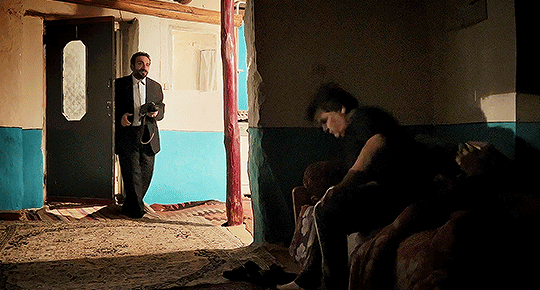

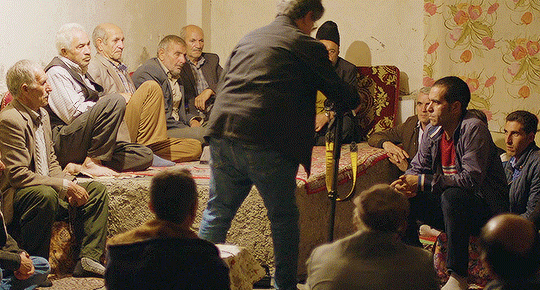
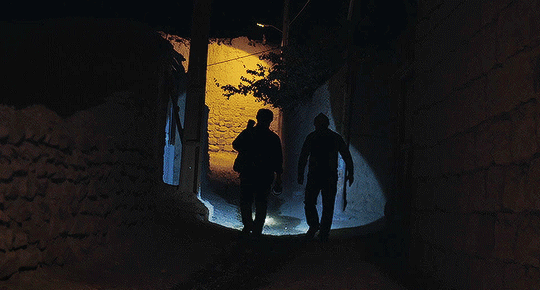

"You're all in this mess just so you can create your happy ending, showing light at the end of the tunnel.
Did you ask yourself, what will happen to me?"
No Bears (2022)
directed by Jafar Panahi
cinematography by Amin Jafari
60 notes
·
View notes
Text
TOC: Semiotica. Journal of the International Association for Semiotic Studies Vol. 2019, No. 229 (2019)
Frontmatter Page i Spontaneous emergence of language-like and music-like vocalizations from an artificial protolanguage Ma, Weiyi / Fiveash, Anna / Thompson, William Forde Page 1 A sociological analysis of moves in the formation of Iranian epitaphs Karimnia, Amin / Mohammad Jafari, Fatemeh Page 25 Sign systems: The dawn of earliest mankind Ruben, Aarne Page 41 L’ambigüité structurale et l’acquisition des compétences linguistiques en français en passant par la langue materne http://dlvr.it/R9251z
0 notes
Link
tobasatu.com, Kualumpur | Untuk pertama kalinya dalam sejarah sepakbola kita, Timnas U-16 Indonesia mampu mengalahkan Timnas U-16 Iran dengan skor 2-0, pada duel perdana Grup C Piala Asia U-16 2018 di Stadion Nasional Bukit Jalil, Kuala Lumpur, Malaysia, Jumat (21/9) sore.
Pasukan Garuda Asia besutan Fakhri Husaini mengawal laga dengan penuh semangat juang tinggi. Hasilnya di menit ke 4, Amiruddin Bagus Kahfi Al-Fikri mampu mencetak gol usai menerima umpan dari Mohammad Supriadi.
Gol Bagus tentu saja mengejutkan skuad Iran yang digadang-gadang favorit juara di turnamen ini. Iran langsung bereaksi setelah gol tersebut. Satu tembakan dilepaskan, namun bola masih bisa diamankan Ernando Ari.
Iran kembali menyengat pertahanan Indonesia. Di menit kesembilan, Alireza Bavieh melepas tembakan namun masih mampu diblok lini pertahanan Indonesia. Tempo permainan mulai melambat setelah laga berjalan 30 menit. Tak ada peluang berarti di sisa waktu babak pertama. Skor 1-0 pun bertahan untuk Indonesia hingga turun minum.
Indonesia langsung mengancam di awal babak kedua. Berawal dari sepak pojok Yudha Febrian, menyambar bola dengan tembakan keras, namun arah bola masih melenceng dari gawang.
Tim besutan Fakhri Husaini nyaris menggandakan skor di menit ke-52. Berawal dari kesalahan kontrol pemain lawan, Bagus mencuri bola untuk kemudian menerobos masuk ke kotak penalti. Tembakan dari jarak dekat dilepaskan, namun bola masih sedikit melebar dari gawang.
Iran masih belum bisa mengancam gawang Indonesia setelah babak kedua berjalan 20 menit. Mereka kerap membuat umpan-umpan silang yang melenceng. Indonesia nyaris kebobolan di menit ke-73. Umpan silang yang dilepaskan Amir Jafari membentur mistar gawang. Tak ada pemain Iran yang siap untuk menyambar bola liar.
Indonesia memperbesar keunggulan di injury time. Amiruddin Bagas Kaffa melesakkan gol setelah melewati tiga pemain Iran. Gol itu mengantarkan Indonesia menang 2-0.
Kemenangan ini untuk sementara mengantarkan Indonesia memimpin Klasemen Grup C dengan tiga poin. Timnas U-16 Indonesia akan kembali tampil pada Senin (24/9/2018) pukul 19:45 WIB melawan Vietnam di Stadion Nasional Bukit Jalil, Kuala Lumpur.(ts)
Susunan Pemain
Iran (4-4-2)
Amirhossein Nikpour; Amirhossein Azizi, Mochammad Amin Hazbavi, Pouria Teymori, Abolfazl Alizadeh; Amir Shabani, Alireza Bavieh (Amirreza Eslamtalab 63′), Mohammad Reza Shakibkhoo, Amir Jafari; Mahdi Seyedi, Yasin Salmani.
Pelatih: Abbas Chamanian
Indonesia (4-3-3)
Ernando Ari; Bagas Kaffa, Komang Teguh Trisnanda, Fadilah Nur Rahman, Yudha Febrian; Brylian Aldama, Andre Oktaviansyah, David Maulana; Amanar Abdillah, Supriadi (Salman 79′), Bagus Kahfi.
Pelatih: Fakhri Husaini
The post Piala AFC U-16: Iran 0 vs 2 Indonesia, Cetak Sejarah Pertama appeared first on tobasatu.com.
0 notes
Text
U.S. sanctions five Iranians it says assisted Yemen
WASHINGTON (Reuters) – The United States on Tuesday imposed sanctions on five Iranians it said had provided Yemen’s Houthis with expertise and weaponry that were then used to launch missiles at cities and oil infrastructure in Saudi Arabia.
U.S. Treasury Secretary Steve Mnuchin speaks during a TV interview at the White House in Washington, U.S., May 21, 2018. REUTERS/Kevin Lamarque
In a statement, the U.S. Treasury named the individuals as Mehdi Azarpisheh, Mohammad Jafari, Mahmud Kazemabad, Javad Shir Amin, and Sayyed Mohammad Tehrani. It said the first four individuals had worked with the Houthis through Iran’s Revolutionary Guards, while Tehrani had helped with the financing of the Revolutionary Guard.
The fresh sanctions, part of President Donald Trump’s pledge to economically suffocate Iran in hopes of hampering the country’s development of nuclear weapons, come one day after Secretary of State Mike Pompeo said the United States would soon crack down on Iran’s support for the Houthis. Yemen’s government has been pitched against the Iran-aligned Houthi movement since 2015 in a war driving the country to the verge of famine.
Reporting by Tim Ahmann and Lisa Lambert; editing by Chizu Nomiyama and Jonathan Oatis
The post U.S. sanctions five Iranians it says assisted Yemen appeared first on World The News.
from World The News https://ift.tt/2IBtPWJ
via Breaking News
0 notes
Text
U.S. sanctions five Iranians it says assisted Yemen
WASHINGTON (Reuters) – The United States on Tuesday imposed sanctions on five Iranians it said had provided Yemen’s Houthis with expertise and weaponry that were then used to launch missiles at cities and oil infrastructure in Saudi Arabia.
U.S. Treasury Secretary Steve Mnuchin speaks during a TV interview at the White House in Washington, U.S., May 21, 2018. REUTERS/Kevin Lamarque
In a statement, the U.S. Treasury named the individuals as Mehdi Azarpisheh, Mohammad Jafari, Mahmud Kazemabad, Javad Shir Amin, and Sayyed Mohammad Tehrani. It said the first four individuals had worked with the Houthis through Iran’s Revolutionary Guards, while Tehrani had helped with the financing of the Revolutionary Guard.
The fresh sanctions, part of President Donald Trump’s pledge to economically suffocate Iran in hopes of hampering the country’s development of nuclear weapons, come one day after Secretary of State Mike Pompeo said the United States would soon crack down on Iran’s support for the Houthis. Yemen’s government has been pitched against the Iran-aligned Houthi movement since 2015 in a war driving the country to the verge of famine.
Reporting by Tim Ahmann and Lisa Lambert; editing by Chizu Nomiyama and Jonathan Oatis
The post U.S. sanctions five Iranians it says assisted Yemen appeared first on World The News.
from World The News https://ift.tt/2IBtPWJ
via Today News
0 notes
Text
U.S. sanctions five Iranians it says assisted Yemen
WASHINGTON (Reuters) – The United States on Tuesday imposed sanctions on five Iranians it said had provided Yemen’s Houthis with expertise and weaponry that were then used to launch missiles at cities and oil infrastructure in Saudi Arabia.
U.S. Treasury Secretary Steve Mnuchin speaks during a TV interview at the White House in Washington, U.S., May 21, 2018. REUTERS/Kevin Lamarque
In a statement, the U.S. Treasury named the individuals as Mehdi Azarpisheh, Mohammad Jafari, Mahmud Kazemabad, Javad Shir Amin, and Sayyed Mohammad Tehrani. It said the first four individuals had worked with the Houthis through Iran’s Revolutionary Guards, while Tehrani had helped with the financing of the Revolutionary Guard.
The fresh sanctions, part of President Donald Trump’s pledge to economically suffocate Iran in hopes of hampering the country’s development of nuclear weapons, come one day after Secretary of State Mike Pompeo said the United States would soon crack down on Iran’s support for the Houthis. Yemen’s government has been pitched against the Iran-aligned Houthi movement since 2015 in a war driving the country to the verge of famine.
Reporting by Tim Ahmann and Lisa Lambert; editing by Chizu Nomiyama and Jonathan Oatis
The post U.S. sanctions five Iranians it says assisted Yemen appeared first on World The News.
from World The News https://ift.tt/2IBtPWJ
via News of World
0 notes
Text
Panahi lanza en Cannes mensaje por la libertad y la igualdad de las mujeres
Alicia García de Francisco Cannes (Francia), 13 may (EFE).- El realizador iraní Jafar Panahi tiene requisado el pasaporte y no ha podido viajar a Cannes para presentar su filme "3 visages", pero su presencia no ha sido necesaria para lanzar su mensaje a favor de la libertad y de la igualdad para las mujeres. Las protagonistas del filme, Behnaz Jafari y Marzieh Rezaei, la montadora, Mastaneh Mahojer, y el director de fotografía, Amin Jafari, defendieron en Cannes con pasión y con la mejor de las sonrisas el trabajo de Panahi, que compite por la Palma de Oro del festival y cuya silla permaneció vacía durante la rueda de prensa. El equipo reconoció que han recibido muchas muestras de solidaridad, sobre todo tras el estreno oficial de la película, anoche. Incluso la actriz iraní Golshifteh Farahani -protagonista de la segunda película en competición de hoy, "Les filles du soleil"- ha mostrado su apoyo a Panahi desde Cannes. Sin embargo, Mahojer reconoció que la prohibición de salir del país y de rodar que pesa sobre Panahi hasta 2030 no puede eliminarse fácilmente. "Pero nosotros no tenemos prohibido viajar al extranjero y el filme tampoco, porque tiene identidad propia", resaltó. Y su presencia en Cannes es suficiente para Panahi, porque a él lo que verdaderamente le importa es mostrar la película, que sea vista en el festival y en el mundo, resaltó la montadora, una de las colaboradoras habituales del director. Ayer por la noche, tras la proyección oficial, hablaron con el realizador y le encontraron contento y lleno de energía porque el filme se pudo proyectar. "Estar él o no, no le importaba tanto", afirmó Amin Jafari, que también precisó que ahora su objetivo es que "3 visages" se estrene en Irán. Un filme que ha sido muy bien recibido en Cannes, con críticas unánimes que coinciden en destacar la sutileza con la que el director trata un tema complicado, el de las dificultades que tienen en Irán las mujeres para acceder a la educación, así como el buen trabajo de Behnaz Jafari, que se interpreta a sí misma. Con un comienzo que descoloca -la grabación de una joven con su móvil de su propio suicidio- la película transcurre sin embargo de forma más relajada de lo que cabría esperar y se convierte también en un retrato del Irán rural y de cómo las costumbres están estancandas desde hace siglos. "3 visages" es el cuarto largometraje que Panahi realiza desafiando la condena que le impusieron en 2010 por "conspiración y propaganda contra el Gobierno iraní" y con uno de ellos, "Taxi", logró el Oso de Oro de Berlín en 2015. Le impusieron seis años de cárcel, una condena que está en suspenso, y 20 años de inhabilitación profesional, que incluye la prohibición de rodar películas y escribir guiones, medida que sí está en vigor. Pese a ello, Panahi puede trabajar en condiciones más o menos normales, aunque las restricciones que pesan sobre él "provocan problemas inesperados", pero el realizador siempre encuentra soluciones a cualquier obstáculo, señaló Mahojer. Incluso prepara dos guiones que avanzan paralelamente, uno el del filme y otro un poco diferente, para evitar los problemas, explicó Amin Jafari con humor. Un humor presente en la rueda de prensa y en la película, pese a los asuntos que trata, y que es un ejemplo del surrealismo que convive con el realismo extremo en Irán. Una vaca que bloquea un camino o una mujer que yace en su tumba, que ella misma ha cavado, para comprobar si estará cómoda, son algunas de esas escenas de humor que contrastan con la dureza de la vida de las mujeres en Irán. Un asunto muy presente en todas las películas de Panahi, como resaltó Mahojer, que consideró que el director iraní ha sido un avanzado en la cuestión "de darle el poder a las mujeres porque casi todos sus filmes están centrados sobre la cuestión femenina". "Mucho antes de que comenzara ese movimiento de 'Me Too' del que todos hablan, él ya provocaba olas en esa dirección y continúa haciéndolo. No solo influye en la cuestión de las mujeres en Irán, también en la del mundo", dijo antes de agregar: "aquí estamos como mujeres que contamos y ese es el mensaje que él quiere dar a Cannes y al mundo". EFE agf/ah
#_author:agf/ah#_revsp:efe.es#_uuid:dd000a2f-f545-3c62-aa33-75d56964845e#_category:yct:001000076#_lmsid:a077000000Kgol7AAB
0 notes
Text
Iranian anthropologist Shahla Haeri pays tribute to her Pakistani behen Asma. Photo: Ibrahim Rashid.
Days after Asma Jahangir passed away in Lahore, some of us, members of Asma’s tribe as I think of it, got together at Harvard to commemorate her life, impact and achievements. We had lots of flowers, and music, and chai and samosas – she loved these things and loved hosting people. The languages spoken — English, Urdu, Punjabi, Bengali and Farsi — are a testament to Asma’s reach. Below, a short report about the event by a student at Emerson College, Boston, and a longer one by a Wellesley College student. Video clips of some speakers’ comments below; all video clips online on Vimeo, courtesy Rick Brotman. Cambridge Community Television will run a full video of the event next Saturday.
People influenced by Asma Jahangir gather in Cambridge to celebrate her life, by Maysoon Khan
Celebrating Asma Jahangir – by Aliza Amin
People influenced by Asma Jahangir gather in Cambridge to celebrate her life
By Maysoon Khan
On a chilly Saturday afternoon in February, students, professionals and community members crowded into an over 100-seater auditorium at the Harvard Kennedy School to celebrate the life of Asma Jahangir, a Pakistani human rights lawyer and social activist who passed away at her hometown in Lahore the previous Sunday, February 11, 2018.
Celebrating Asma Jahangir-Amartya Sen from Rick Brotman on Vimeo.
An assortment of people who worked with and knew Jahangir personally paid tribute by sharing stories and reading poetry at an event organized by Jahangir’s friends and admirers including students.
What Asma means to me – a whiteboard series. Photos: Ibrahim Rashid
Introducing the event, Beena Sarwar, a Pakistani journalist who worked with Jahangir, said, “We were originally going to call this a memorial service, then we called it a remembrance, and then we decided to call it a celebration. We want this to be an uplifting celebration of Asma.” Sarwar first met Jahangir when she started voluntary work reporting and writing for the Human Rights Commission in Lahore in the late 1980s.
Speakers ranged from cardiologist Kashif Choudhry who flew in from Baltimore to pay his respects, to entrepreneur Mahmud Jafari, historians Ayesha Jalal and Sugata Bose, writers Sara Suleri and Homi Bhabha, to Nobel Laureate economist Amartya Sen, to a chaplain, lawyers, professors and newspaper editors.
Asma Jahangir was more than just a lawyer and activist. She was a fearless leader and mentor who fought for justice and democracy in a society that is heavily conservative and marred by corruption. She remained undeterred in the face of imprisonment, beatings, and death threats.
She co-founded Pakistan’s first all-women law firm in 1980, the Women’s Action Forum in 1981, Human Rights Commission of Pakistan in 1987 and was also the first woman president of Pakistan’s Supreme Court Bar Association. She took up cudgels on behalf of women, laborers and other marginalized communities in Pakistan. In her role setting up institutions as well as being an activist, she was revolutionary.
Additionally, she was a long serving UN Special Rapporteur who held several portfolios: 1998 to 2004 on extrajudicial, summary or arbitrary executions, 2004 to 2010 on freedom of religion or belief, and mostly recently on the situation of human rights in Iran, a position she assumed on 1 November 2016 and held until her death.
Celebrating Asma Jahangir-Shahla Haeri from Rick Brotman on Vimeo.
Tufts professor Ayesha Jalal, a close friend of Jahangir, said, “You could find her at 7:30 in the morning at the bazaar buying fish. And at 10 am protesting outside the Lahore High Courts, and going to courts to fight her case, and then attending a funeral for a human rights activist, and then going home and making dinner and entertaining friends till 3 a.m.” Laughter resounded through the hall.
The auditorium reverberated with emotion, as speakers remembered Asma Jahangir through both laughter and tears. She was remembered as a ‘mentor of mentors’, as ‘Pakistan’s conscience’, and as a national icon whose courage was needed today more than ever to stand up to the tyranny in Pakistan.
“No country produces only heroes. But no country should do without heroes who can give us examples of integrity, courage, and honesty,” said Thomas W. Simons, former United States ambassador to Pakistan.
At the end, the organizers called for the young people present to continue Jahangir’s legacy, to be the next voice of optimism, and to “overcome sounds of war drums with courage.”
(ends)
Celebrating Asma Jahangir: “We will not stop. We will take her work forward”
By Aliza Amin
A memorial titled “Celebrating Asma Jahangir” at Harvard Kennedy School on 17 February 2018 was held to honor to the late lawyer and human rights activist, who passed away on 11 February 2018 in Lahore from a cardiac arrest at age 66. She will be remembered for championing the rights of marginalized communities including women and children, workers, low-income and religious minorities, and ethnic minorities for almost four decades. She is survived by her husband, two daughters, and a son. Her funeral prayers at Lahore’s Gaddafi Stadium in Pakistan were attended by over 3,000 people, around half of them women.
In Cambridge MA, students, community members, writers and professionals, including many who came in from out of town, gathered to pay their last respects at the well-attended event, organized by friends and admirers of Asma Jahangir.
The event began with an introduction by Beena Sarwar, who first learnt of Asma Jahangir through the Woman’s Action Forum launched in 1981, and subsequently worked with her at the Human Rights Commission of Pakistan that Jahangir started in 1987. Sarwar praised Jahangir and her ability to change and inspire the lives of so many.
“We lost someone who meant a lot to people who knew her as well as those who did not know her because she took on issues such as rule of law, due process, and the democratic political process,” said Sarwar. “We will not stop. We will take her work forward.”
Lawyer Yasser Kureshi, a doctoral candidate from Brandeis University, gave a brief summary of Jahangir’s achievements before introducing each speaker to the podium.
Entrepreneur and philanthropist Mahmud Jafari described Jahangir as “a small person with an indomitable will.” He shared the text of a Facebook post that had been widely shared, written by Zahra Hayat, recounting her experience attending the activist’s funeral in Lahore and how moving it was to see men and women gathered in congregation. He also recited a poem by Urdu poet Kishwar Naheed, written specifically for Jahangir.
“She had no fear of speaking truth to power,” said Shahla Haeri, an associate professor of anthropology at Boston University who had met Jahangir while conducting research in Pakistan. “A person with a good name never dies,” she stated, alluding to a couplet written by the Persian poet Sa’adi.
Celebrating Asma Jahangir-Yasser Latif Hamdani from Rick Brotman on Vimeo.
Yasser Latif Hamdani, an advocate of the Lahore High Court and Visiting Fellow at Harvard Law School, said Jahangir was one of his inspirations when he entered the field of law. He considered her to be a mother figure.
Martha Chen, who teaches Public Policy at Harvard University, recalled the time she and Jahangir first met at a conference in Sweden. They discovered that they had much in common, Chen said. Both had attended Christian schools, had a deep admiration of the Urdu language, and been active in protesting the atrocities in then East Pakistan, 1971, and had fought for the recognition of Bangladesh.
Celebrating Asma Jahangir-Marty Chen from Rick Brotman on Vimeo.
Editor of Daily Times Pakistan Raza Rumi had worked with Jahangir while he was an intern at the Center for Advocacy and Rights and witnessed her courage firsthand when she confronted the inspector general of a police station for their inaction over a gang rape case. She continued to display such bravery, he said, as she stood against arrays of killings, missing persons, and brick kiln workers. Rumi talked about AGHS Legal Aid Cell that Jahangir founded with other young women lawyers, which continues to remain a valuable resource for minorities, women, and children.
Celebrating Asma Jahangir-Raza Rumi from Rick Brotman on Vimeo.
“In her home country, she was a firebrand activist and a fearless lawyer. Through her work she ensured that a military dictator, however powerful, would always be regarded as a usurper. In India, she was a messenger of peace and goodwill,” said Sugata Bose, a historian at Harvard University. His mother in India had once nominated Jahangir for a Gandhi Peace Prize, which later received backlash and was disregarded.
Chanta Bhan, an interfaith chaplain originally from Lahore, talked about Dastak, the women’s shelter in Lahore set up through AGHS Legal Aid Centre that Asma Jahangir ran along with her sister Hina Jillani. Dastak remains an exemplary interfaith sanctuary, where Christian and Muslim women live together when they have nowhere else to go.
Celebrating Asma Jahangir-Chanta Bhan from Rick Brotman on Vimeo.
“The sheer integrity of Asma’s voice as a feminist activist is more resonant and relevant today than ever,” said Homi Bhabha, an English professor at Harvard University. “Her struggle must never end because we must interiorize the struggle and make it part of our internal ethical vigilance. We struggle not only against tyranny but for truth that we cannot live without.”
Kashif Chaudhry, a cardiologist at the University of Maryland who had flown in for the event from Baltimore, praised Jahangir’s unrelenting support for religious minorities such as Ahmadi Muslims. “No words can suffice to pay tribute to Asma Jahangir,” said Chaudhry.
“One of my favorite authors, the Viennese writer Karl Kraus, was called a faithful hater of his fatherland,” said former US ambassador to Pakistan Thomas W. Simons, Jr. “And there was something of that in the way Asma felt about her country.”
He went on to speak of her heroism and integrity, concluding, “I must also share with you my first reaction to the news of her death: Pakistan, you’re on your own.”
Author Sara Suleri, Professor Emeritus of English at Yale University, paid tribute to Jahangir’s authenticity of spirit and courage by sharing anecdotes of their decades-long friendship. “She did not have to speak for women. She personified what the travails were to women around and also provided some solutions for our predicament.”
“I would hope that the sense of immediate loneliness is mitigated by this occasion,” said Suleri. “We are all learning a language that is post-Asma Jahangir, and I encourage all of us to keep practicing it.”
Historian Ayesha Jalal, another old friend of Jahangir’s, talked about how remarkable it was that she could manage politics and be a friend and a mother all at once. She reminded the audience that Jahangir was a fallible human being with worries and concerns, and that we all must do even better than her.
Celebrating Asma Jahangir-Ayesha Jalal from Rick Brotman on Vimeo.
“When the canons of Pakistani democracy are put together, this small-framed friend of mine will stand amongst the tallest of giants,” said Jalal.
Nobel Prize-winning economist Amartya Sen recounted some of Jahangir’s numerous achievements while she was alive, such as how she won her first case at a mere age of 18 and went on to become a leading defender of human rights in Pakistan. The two had been close friends for over two decades, and Sen described how awestruck he was by Jahangir’s clarity of mind and boundless humanity.
“The angel of humanity may have gone, but the education and training we got from her is here to stay,” Sen said. “We can have pride in having known so perfect of a human being.”
The event concluded with a poetry reading by Sughra Raza, an associate professor at Harvard Medical Center. She recited passages “Shorish-e-Barbat-o-Nai” by Faiz Ahmed Faiz, a dialogue on hope by two different voices. The first voice speaks of the pain of destiny and annihilation, to which the second voice responds with hope and commitment to truth and to overthrow the sound of war drums with music.
(ends)
Asma’s tribe: a remembrance at Harvard Days after Asma Jahangir passed away in Lahore, some of us, members of Asma's tribe as I think of it, got together at Harvard to commemorate her life, impact and achievements.
0 notes